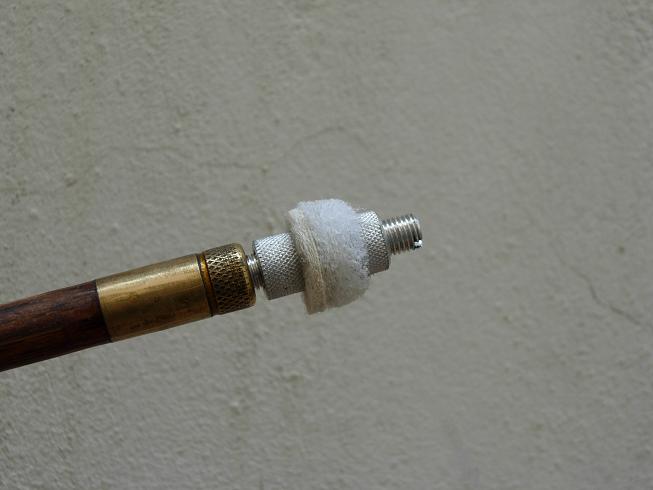INSTRUCTIONS
Cleaning Mode
Threading the Borekisser onto the cleaning rod
1-Thread Borekisser onto the cleaning rod using THUMB PRESSURE ONLY. The slot faces outwards. Simple finger pressure is enough, overtightening can harm the soft aluminum threads of the Borekisser or the soft brass of the rod.
Place one soft white foam pad and one hard white disc on the Borekisser shaft, trapping them between the two kunrled nuts.
Pass Borekisser with oiled towel through barrel till towel is clean
Let the oil do its work and then pass with clean patches or paper towel wrapped on the Borekisser till they come out clean.
When the pads get clogged with fouling you can wash them by shaking them in a jar filled with a weak solution of water and dish washing liquid.
4-The white Schotchbrite pads are non abrasive. We DO NOT recommend using any other color Schotchbrite due to their abrasive action.
Polishing, Bore Conditioning Mode
Use one felt pad on the Borekisser
1-Use one felt pad on the Borekisser. Apply a light coat of fine polishing compound on the felt pad. Use only polishing compound, DO NOT USE GRINDING COMPOUNDS, they will score your barrel.
Place a FINE polishing compound on the felt pad
We recommend fine polishing compounds such as Brasso, Flitz, Glanol Gloss Formula, and similar FINE polishing media.
Keep using same pad; add polisher before every use
2-Keep using the same wool pad, simply add some polishing compound each time you use it. The more you use it the better it will polish. Use a new pad when it is worn and no longer makes firm contact with the bore.
Polish bore in long, even moves for twenty passes
3-Using a to and fro motion polish the bore in long, even moves for about twenty passes is about enough. More will not harm the bore.
Clean residue off pad with towl or tissue
4-Then wrap kitchen towl or tissue around the pad and clean off the residue.
Even clean barrels may contain large amounts of residue
It is amazing how much gunk comes out of a bore by polishing, even in a clean barrel!
Polishing after cleaning has overall beneficial effects on barrel
5-Polishing after every cleaning will yield a barrel which will resist fouling, will be easier to clean and according to some, will kick less.
Polishing is suitable for chromed and unchromed barrels. The fine compounds on the wool felt polish the outermost surface of the bore.
Fine polishing compounds are safe, as they do not remove metal. DO NOT USE ABRASIVES.
We DO NOT recommend polishing with a power drill. The high revolutions of the drill can generate heat which might put the rib solder at risk.
Pull Through Field Use Mode
We recommend that a cleaning rod is used with the Borekisser. A cleaning rod is also useful in the field and at the range for removing stuck shells, obstructions and debris that might find their way into the barrel. However, it is possible to make a pull through for field use when a cleaning rod might not be practical to carry.
Thread washer through string
1-Take a an ALUMINUM or BRASS washer and thread through some strong, unbreakable string or fishing line. Tie the line securely to the washer. Do not use steel or iron washers as they might scratch your barrel. Use double strands of line for safety. Allow enough length to reach easily through your barrel.
